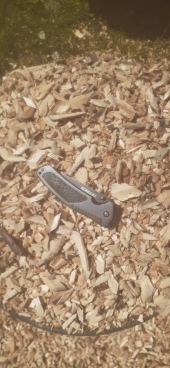Update!
The goal was to improve clay soil over the winter so I could plant in it this spring.
The plan was:
- Get the wood mill to deliver a truckload of wood chips/chunks. Spread it on the soil as deep as possible. Mix in some hay or straw and seasoned used coffee grounds if possible.
- Plant winecap spawn.
- Use 12"x12" fertile holes to grow some summer vegs.
- At the end of August, plant daikon, hollyhocks, rye.
- Meanwhile, start a compost pile.
- Look into adding Tennessee Red peanuts into the mix.
The reality was:
- Wood chips/chunks aren't really available here. Nor is straw. Any hay would be likely to be treated. What I managed to get was wood SHAVINGS. Since it was all I could get, I tried it. I spread a few inches over the ground in the late summer and left it there all winter. It ... didn't do much. I ended up raking it all up and now I'm using it on paths (it soaks up the mud really well) and am using it in the compost heap, which probably isn't ideal but seems to be working okay.
- I planted winecap spawn in the fall, in those same wood chips plus what leaves I could get. It hasn't done much - I understand it can take a full season - but there is a lot of mycelium activity in the chip pile. Lots of white fibers. So I'm taking bits of that and spreading it around the garden.
- The fertile holes worked great. I got tons of summer squash and some lettuce and carrots by doing that.
- The daikons didn't do much. Only one got to any size. I ate it. It was good.
- I planted the hollyhocks in the fall and they stayed teeny tiny, until recently they started putting on size. So it looks like I'll have some blossoms this year, but it wasn't a helpful tactic for improving the soil over the winter.
- I didn't plant rye, and I forget why. I think because it didn't look likely that it would be able to grow in the wood shavings.
- Composting is going great. I'll be able to get lots of material, so I'll make as much as I can. I have one bin now that I hope will be ready for use in the garden by May.
- I've learned it doesn't get warm enough here for peanuts to do much. I have a packet of seeds but I might just eat them.
So nothing I did made any difference with the clay. It was all so ineffectual that I've abandoned the idea of trying to transform it.
BUT I learned I could get what people around here call terra preta. Don't get excited, it's not like the fabled terra preta of the Amazon. It's just soil that's much darker in color than the clay that's everywhere here, and according to the guy at the ag store, it's great to grow vegetables in. He claims it's naturally pH 7.0 and has plenty of potassium. They don't even sell potassium around here because, he says, people don't need it. So I had nine meters of it delivered, and I terraced the garden area, and created beds of that terra preta on top of the clay. I've planted buckwheat in the new soil and have added biochar. In April I'll hoe in the buckwheat and let it sit a while and then I'll plant.
So that's that! I have other issues about the (non) availability of organic fertilizers here, but that's another story.
before

after

Many thanks to everyone who offered ideas and information.
Patricia



 So NEXT fall it should be doable to round up a few wheelbarrows full of fresh manure and make my own pile. Thanks John! I wouldn't have walked down there if you hadn't suggested it!
So NEXT fall it should be doable to round up a few wheelbarrows full of fresh manure and make my own pile. Thanks John! I wouldn't have walked down there if you hadn't suggested it!






